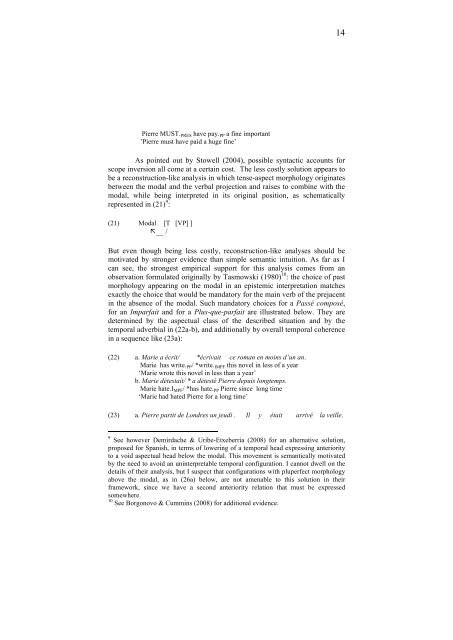On modal tenses and tensed modals - UMR 7023 - CNRS
On modal tenses and tensed modals - UMR 7023 - CNRS
On modal tenses and tensed modals - UMR 7023 - CNRS
You also want an ePaper? Increase the reach of your titles
YUMPU automatically turns print PDFs into web optimized ePapers that Google loves.
Pierre MUST.PRES have pay.PP a fine important<br />
’Pierre must have paid a huge fine’<br />
14<br />
As pointed out by Stowell (2004), possible syntactic accounts for<br />
scope inversion all come at a certain cost. The less costly solution appears to<br />
be a reconstruction-like analysis in which tense-aspect morphology originates<br />
between the <strong>modal</strong> <strong>and</strong> the verbal projection <strong>and</strong> raises to combine with the<br />
<strong>modal</strong>, while being interpreted in its original position, as schematically<br />
represented in (21) 9 :<br />
(21) Modal [T [VP] ]<br />
�__ /<br />
But even though being less costly, reconstruction-like analyses should be<br />
motivated by stronger evidence than simple semantic intuition. As far as I<br />
can see, the strongest empirical support for this analysis comes from an<br />
observation formulated originally by Tasmowski (1980) 10 : the choice of past<br />
morphology appearing on the <strong>modal</strong> in an epistemic interpretation matches<br />
exactly the choice that would be m<strong>and</strong>atory for the main verb of the prejacent<br />
in the absence of the <strong>modal</strong>. Such m<strong>and</strong>atory choices for a Passé composé,<br />
for an Imparfait <strong>and</strong> for a Plus-que-parfait are illustrated below. They are<br />
determined by the aspectual class of the described situation <strong>and</strong> by the<br />
temporal adverbial in (22a-b), <strong>and</strong> additionally by overall temporal coherence<br />
in a sequence like (23a):<br />
(22) a. Marie a écrit/ *écrivait ce roman en moins d’un an.<br />
Marie has write.PP/ *write.IMPF this novel in less of a year<br />
‘Marie wrote this novel in less than a year’<br />
b. Marie détestait/ * a détesté Pierre depuis longtemps.<br />
Marie hate.IMPF/ *has hate.PP Pierre since long time<br />
‘Marie had hated Pierre for a long time’<br />
(23) a. Pierre partit de Londres un jeudi . Il y était arrivé la veille.<br />
9 See however Demirdache & Uribe-Etxeberria (2008) for an alternative solution,<br />
proposed for Spanish, in terms of lowering of a temporal head expressing anteriority<br />
to a void aspectual head below the <strong>modal</strong>. This movement is semantically motivated<br />
by the need to avoid an uninterpretable temporal configuration. I cannot dwell on the<br />
details of their analysis, but I suspect that configurations with pluperfect morphology<br />
above the <strong>modal</strong>, as in (26a) below, are not amenable to this solution in their<br />
framework, since we have a second anteriority relation that must be expressed<br />
somewhere.<br />
10 See Borgonovo & Cummins (2008) for additional evidence.

















